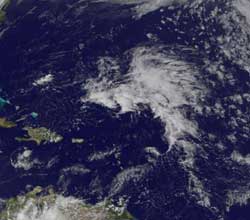GOES-13 sees an extraordinarily early Atlantic low in the tropics

This visible image of the early tropical low several hundred miles north-northeast of Puerto Rico was captured on April 20 at 17:45 UTC (1:45 p.m. EDT) from the GOES-13 satellite. Credit: NOAA/NASA GOES Project<br>
The National Hurricane Center (NHC) issued a Special Tropical Weather Outlook today, April 20, that noted the low pressure area was located about 460 miles northeast of San Juan, Puerto Rico at 3:35 p.m. EDT. The NHC noted that slow development is possible over next couple of days. The low is moving west -northwest at 10mph.
The image was created using satellite imagery was captured on April 20 at 17:45 UTC (1:45 p.m. EDT) from the Geostationary Operational Environmental Satellite (GOES-13). Although it is not easy to pick out the center of circulation in the image, it is located to the west of the largest area of clouds.
GOES satellites are operated by the National Oceanic and Atmospheric Administration. The image was created by NASA's GOES Project, located at NASA's Goddard Space Flight Center, Greenbelt, Md.
The NHC gives this low a 20 percent chance of development into a sub-tropical or tropical storm over the next two days before it hits wind shear, which will weaken it.
Media Contact
More Information:
http://www.nasa.govAll latest news from the category: Earth Sciences
Earth Sciences (also referred to as Geosciences), which deals with basic issues surrounding our planet, plays a vital role in the area of energy and raw materials supply.
Earth Sciences comprises subjects such as geology, geography, geological informatics, paleontology, mineralogy, petrography, crystallography, geophysics, geodesy, glaciology, cartography, photogrammetry, meteorology and seismology, early-warning systems, earthquake research and polar research.
Newest articles

Sea slugs inspire highly stretchable biomedical sensor
USC Viterbi School of Engineering researcher Hangbo Zhao presents findings on highly stretchable and customizable microneedles for application in fields including neuroscience, tissue engineering, and wearable bioelectronics. The revolution in…

Twisting and binding matter waves with photons in a cavity
Precisely measuring the energy states of individual atoms has been a historical challenge for physicists due to atomic recoil. When an atom interacts with a photon, the atom “recoils” in…

Nanotubes, nanoparticles, and antibodies detect tiny amounts of fentanyl
New sensor is six orders of magnitude more sensitive than the next best thing. A research team at Pitt led by Alexander Star, a chemistry professor in the Kenneth P. Dietrich…





















